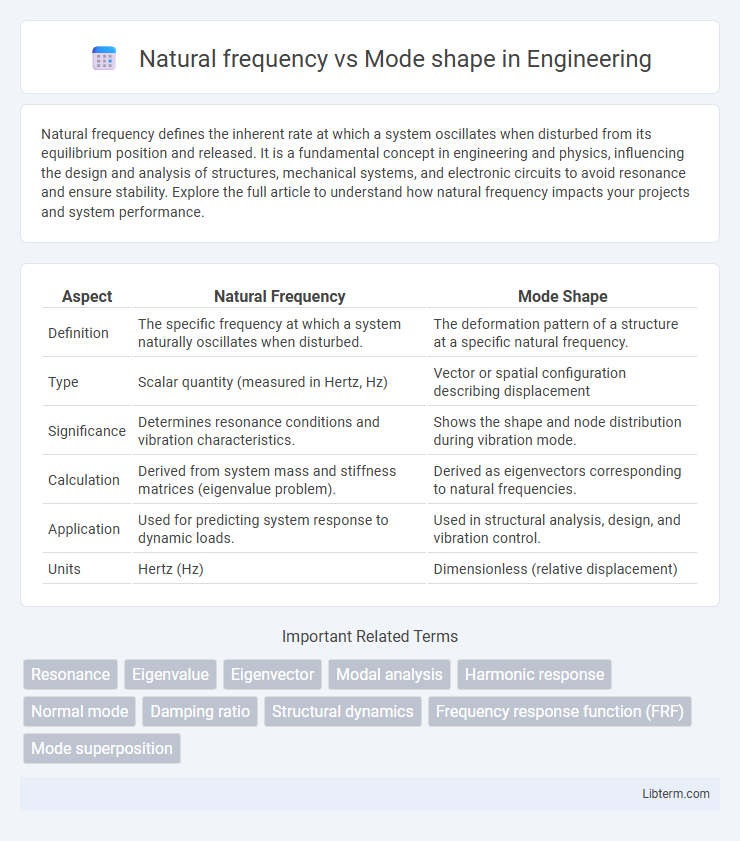Natural frequency defines the inherent rate at which a system oscillates when disturbed from its equilibrium position and released. It is a fundamental concept in engineering and physics, influencing the design and analysis of structures, mechanical systems, and electronic circuits to avoid resonance and ensure stability. Explore the full article to understand how natural frequency impacts your projects and system performance.
Table of Comparison
| Aspect | Natural Frequency | Mode Shape |
|---|---|---|
| Definition | The specific frequency at which a system naturally oscillates when disturbed. | The deformation pattern of a structure at a specific natural frequency. |
| Type | Scalar quantity (measured in Hertz, Hz) | Vector or spatial configuration describing displacement |
| Significance | Determines resonance conditions and vibration characteristics. | Shows the shape and node distribution during vibration mode. |
| Calculation | Derived from system mass and stiffness matrices (eigenvalue problem). | Derived as eigenvectors corresponding to natural frequencies. |
| Application | Used for predicting system response to dynamic loads. | Used in structural analysis, design, and vibration control. |
| Units | Hertz (Hz) | Dimensionless (relative displacement) |
Introduction to Natural Frequency and Mode Shape
Natural frequency refers to the specific frequencies at which a system naturally oscillates when disturbed from its equilibrium position. Mode shape describes the particular pattern or deformation of the system corresponding to each natural frequency during vibration. Understanding the relationship between natural frequencies and mode shapes is essential in structural dynamics, mechanical engineering, and vibration analysis for predicting system behavior and avoiding resonance.
Defining Natural Frequency
Natural frequency refers to the specific frequency at which a system or structure tends to oscillate in the absence of external forces or damping. It is determined by the system's physical properties, such as mass and stiffness, and represents the rate at which the system vibrates naturally. Mode shape describes the deformation pattern of the system corresponding to each natural frequency, illustrating how different parts of the structure move relative to one another during vibration.
Understanding Mode Shape
Mode shape represents the specific deformation pattern a structure undergoes at its natural frequency when vibrating. It reveals how different points within the structure move relative to one another during oscillation, providing critical insight into stress distribution and potential failure points. Understanding mode shapes is essential for designing structures to avoid resonance and ensure structural integrity under dynamic loads.
Key Differences Between Natural Frequency and Mode Shape
Natural frequency represents the specific frequencies at which a system naturally oscillates without external force, while mode shape illustrates the deformation pattern or displacement configuration during those vibrations. Each natural frequency corresponds to a unique mode shape, describing how different points in the structure move relative to each other. Understanding the key differences between natural frequency and mode shape is crucial for analyzing dynamic behavior, vibration control, and structural design optimization.
The Role of Natural Frequency in Structural Dynamics
Natural frequency determines the specific rates at which structures inherently vibrate when subjected to dynamic forces, critically influencing resonance phenomena and structural stability. Mode shapes represent the deformation patterns at each natural frequency, providing insight into how different structural parts move relative to each other during vibration. Understanding natural frequencies is essential for designing buildings, bridges, and mechanical components to avoid resonant conditions that can lead to excessive vibrations and potential failure.
The Importance of Mode Shape in Engineering Analysis
Mode shape defines the specific deformation pattern an object undergoes at its natural frequency, directly influencing stress distribution and potential failure points in engineering structures. Understanding mode shape allows engineers to predict resonant behavior and design components to avoid detrimental vibrations, ensuring structural integrity and longevity. Accurate mode shape analysis is crucial for optimizing dynamic performance and mitigating fatigue in complex mechanical and civil engineering systems.
Mathematical Representation of Natural Frequency and Mode Shape
Natural frequency is mathematically represented as the square root of the eigenvalue obtained from solving the system's characteristic equation, typically expressed as o = (k/m) for a single degree of freedom system, where k denotes stiffness and m denotes mass. Mode shape corresponds to the eigenvector associated with each natural frequency, indicating the relative displacement pattern of the system's nodes during vibration. The analysis involves solving the matrix equation [K - o2M]Ph = 0, where K is the stiffness matrix, M is the mass matrix, o2 are the eigenvalues (squared natural frequencies), and Ph represents the mode shape vectors.
Experimental Methods for Identifying Natural Frequencies and Mode Shapes
Experimental methods for identifying natural frequencies and mode shapes commonly involve modal testing techniques such as impact hammer testing and shaker excitation. These methods measure the system's dynamic response through sensors like accelerometers or laser vibrometers to capture frequency response functions (FRFs), which reveal the natural frequencies as resonance peaks and the corresponding mode shapes from movement patterns. Advanced data processing and curve fitting algorithms enhance the accuracy of extracting modal parameters, enabling precise characterization of a structure's dynamic behavior.
Applications in Engineering and Real-World Examples
Natural frequency identifies the specific frequencies at which structures or mechanical systems tend to oscillate with maximum amplitude, essential for diagnosing potential resonant failures in bridges, buildings, and machinery. Mode shape describes the deformation pattern of a structure at these natural frequencies, enabling engineers to predict stress points and optimize design for earthquake-resistant buildings and aerospace components. In automotive engineering, analyzing natural frequencies and mode shapes helps reduce noise, vibration, and harshness (NVH), improving vehicle durability and passenger comfort.
Conclusion: Integrating Natural Frequency and Mode Shape Analysis
Integrating natural frequency and mode shape analysis enhances structural dynamics understanding, enabling precise identification of resonance conditions and deformation patterns. This combined approach improves predictive maintenance by pinpointing critical vibration modes that impact structural integrity. Engineers leverage both parameters to optimize design, ensuring safety and performance under dynamic loading.
Natural frequency Infographic

 libterm.com
libterm.com